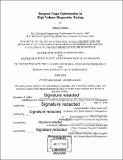Reagent usage optimization In high volume diagnostics testing
Author(s)
Sonmez, Hakan
DownloadFull printable version (6.337Mb)
Other Contributors
Leaders for Global Operations Program.
Advisor
Arnold Barnett and David Simchi-Levi.
Terms of use
Metadata
Show full item recordAbstract
Company X provides healthcare diagnostics testing services. The company competes in the market by providing cost effective, short turn-around-time (TAT) solutions and a large variety of test selections. Reducing operating costs is a major area of ongoing improvement for Company X, and this effort includes reducing reagent costs in high volume diagnostics platforms across the nation. The objective of this thesis is to identify the major causes of reagent waste, and reduce unnecessary reagent consumption on a specific high volume testing platform which can test multiple different assays. The project targeted finding measures to mitigate reagent waste which can be employed in all sites. The current state analysis identified quality control testing that exceeded regulatory requirements and minimum standards defined in the SOPs and unoptimized distribution of assays to instruments as causes of unnecessary reagent consumption. The analysis also identified patient tests repeated due to mechanical errors in the instruments as another cause of reagent waste. Countermeasures are developed to mitigate these issues. In order to reduce reagent consumption due to superfluous quality control testing, a workflow study is conducted. The workflow study targets the minimization of quality control testing and instrument calibrations by optimizing the load distribution over similar instruments within a laboratory site. The optimal distribution of patient test volumes to instruments is modeled and solved as a linear programming problem. In addition to workflow optimization, process standardization and preventive maintenance strategies are explored.
Description
Thesis: M.B.A., Massachusetts Institute of Technology, Sloan School of Management, in conjunction with the Leaders for Global Operations Program at MIT, 2018. Thesis: S.M., Massachusetts Institute of Technology, Department of Civil and Environmental Engineering, in conjunction with the Leaders for Global Operations Program at MIT, 2018. Cataloged from PDF version of thesis. Includes bibliographical references (page 67).
Date issued
2018Department
Leaders for Global Operations Program at MIT; Massachusetts Institute of Technology. Department of Civil and Environmental Engineering; Sloan School of ManagementPublisher
Massachusetts Institute of Technology
Keywords
Sloan School of Management., Civil and Environmental Engineering., Leaders for Global Operations Program.